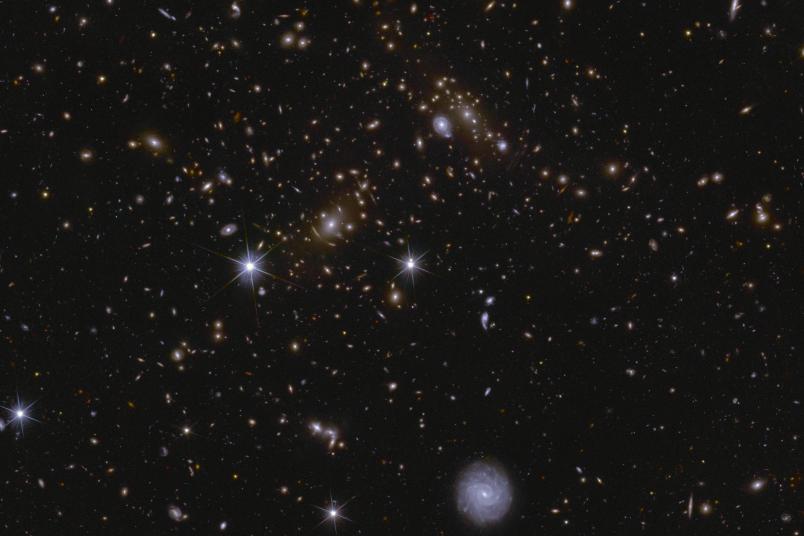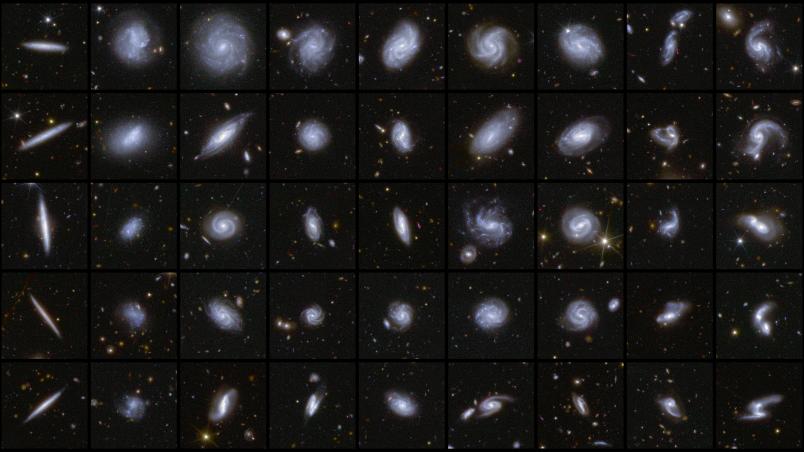
This image shows an area of Euclid’s Deep Field South. The area is zoomed in 70 times compared to the large mosaic. Various huge galaxy clusters are visible in this image, as well as intra-cluster light, and gravitational lenses. The cluster near the centre is called J041110.98-481939.3, and is located almost 6 billion light-years away.
Cosmology
Euclid Opens Data Treasure Trove
With the Euclid mission, Germany is making a major contribution in unveiling the dark universe. Bochum scientist Hendrik Hildebrandt is part of the Euclid team.
Germany’s members of the Euclid Consortium have played a significant role in producing the mission’s first large set of survey data which the European Space Agency has just released. The data includes stunning images of deep fields with a breathtaking number of 26 million galaxies, many showing their detailed structures. More than 380,000 galaxies have been characterized according to their shapes and distances. Nevertheless, this impressive milestone is only a foretaste of what we can expect in the coming years.
Covering a vast sky area in three mosaics, the data release also includes numerous galaxy clusters, active galactic nuclei and transient phenomena. This first survey data unlocks a treasure trove of information for scientists to dive into and tackle some of the most intriguing questions in modern science. Euclid enables us to explore our cosmic history and the invisible forces shaping our universe.

This graphic shows the location of the Euclid Deep Fields (yellow). This all-sky view is an overlay of ESA Gaia’s star map from its second data release in 2018 and ESA Planck’s dust map from 2014. The sky is shown in the Galactic coordinate system, with the bright horizontal band corresponding to the plane of our Milky Way galaxy, where most of its stars reside.
With its exceptionally large field of view for a space telescope, capturing an area 240 times larger in a single shot than the Hubble Telescope, Euclid delivers outstanding image quality in both the visible and infrared light spectrum.
Crucial contributions from Germany
Euclid is particularly impressive in the infrared channel, for which the Max Planck Institute for Extraterrestrial Physics (MPE) in Garching near Munich and the Max Planck Institute for Astronomy (MPIA) in Heidelberg provided critical components. After passing through four lenses, a filter, and a beam splitter, it achieves an extraordinarily high contrast. “The requirements for suppressing ghost images are exceeded by a factor of one hundred. The optical design and the precise execution of the optics at MPE and MPIA set new standards for image sharpness and contrast,” says Frank Grupp, who led the development of the near- infrared optics at MPE.
MPE is also contributing to research on galaxy evolution. “We have compiled a catalogue of over 70,000 spectroscopic redshifts from various sky surveys and combined it with the Euclid data,” explains Christoph Saulder, who led this part of the project. “This catalogue allows for precise distance measurements and the clear identification of numerous galaxies and quasars in Euclid’s high-resolution images. It serves as a foundation for a deeper understanding of these objects, their distribution, and their internal properties.”
“The new data are also being used to test the techniques for measuring cosmic shear and calibrating redshifts, which will soon be applied to the much larger Euclid data sets to achieve the primary scientific goal – the precision measurement of dark energy,” says Hendrik Hildebrandt, head of the working group Observational Cosmology at Ruhr University Bochum. He leads the key project for measuring cosmic shear and the redshift calibration task force.
Furthermore, scientists at Ludwig Maximilian University (LMU) in Munich have tested methods to identify and characterize galaxy overdensities, a crucial step in tracing the universe's large-scale structure. “The methodologies used to pinpoint galaxy clusters in this task will be key to fully exploiting Euclid’s vast dataset, improving cluster identification and contributing to a deeper understanding of cosmic structure formation. At the same time, they help explore previously uncharted regimes in the near-infrared with a statistically significant sample of objects,” says LMU scientist Barbara Sartoris.
Likewise, MPIA scientists play leading roles in numerous Euclid studies. They use the data to identify growing supermassive black holes, answer fundamental questions about galaxy evolution, and perform precise photometric measurements of young and old transient celestial objects.
Tracing out the cosmic web in Euclid’s deep fields
Euclid has scouted out the three areas in the sky where it will eventually provide the deepest observations of its mission. In just one week of observations and one scan of each region so far, Euclid spotted already 26 million galaxies. The most distant of those are up to 10.5 billion light-years away. The fields span a combined area equivalent to more than 300 times the full Moon.

This is Euclid’s Deep Field Fornax. After only one observation, the space telescope already spotted 4.5 million galaxies in this field. In the coming years, Euclid will make 52 observations of this field to reach its full depth. Euclid’s Deep Field Fornax spans 12.1 square degrees and is located in the southern constellation Fornax, the furnace. It encompasses the much smaller Chandra Deep Field South, a 0.11 square degree region of the sky that has been extensively surveyed in the past couple of decades with NASA's Chandra and ESA's XMM-Newton X-ray observatories, as well as the NASA/ESA Hubble Space Telescope and major ground-based telescopes. You can zoom into this image in ESASky.
In order to unravel the mysteries it is designed to explore, Euclid precisely measures the various shapes and the distribution of billions of galaxies with its high-resolution imaging visible instrument (VIS). In contrast, its near-infrared instrument (NISP) is essential for determining galaxy distances and masses.
MPE was responsible for designing and constructing the NISP near-infrared optics. In turn, MPIA carries out crucial tasks for NISP’s calibration. “MPIA engineers and scientists are developing and maintaining the mission’s entire calibration plan, calibrating and scientifically monitoring the near-infrared camera NISP, performing simulations, and conducting technical analyses such as instrument monitoring,” says MPIA’s Mischa Schirmer. He is the Euclid mission calibration and NISP calibration scientist.
The new images are a testimony to these efforts and showcase Euclid's capability of mapping hundreds of thousands of galaxies, and start to hint at the large-scale organization of these galaxies in the cosmic web.
Data processing and object classification
Euclid is expected to capture images of more than 1.5 billion galaxies over six years, sending back around 100 gigabyte of data daily. Such an impressively large dataset creates incredible discovery opportunities, but also poses enormous challenges.
The Euclid consortium has established a European network of nine data centers, including the German Science Data Center (SDC-DE) at MPE. It is equipped with 7,000 processors and processes ten percent of the data recorded by Euclid. A team of at least ten experts ensures smooth and consistent processing of astronomical imaging data. MPE’s Max Fabricius, who leads the SDC-DE, says: “Approximately 100 gigabyte of raw data is processed virtually in real time every day. The demands on photometric precision are enormous and require a completely new approach to the methods used to calibrate the data.”
When it comes to searching for, analyzing and cataloguing galaxies, the advancement of machine learning algorithms, in combination with thousands of human citizen science volunteers and experts, is playing a critical role. It is a fundamental and necessary tool to fully exploit Euclid’s vast dataset. A significant landmark in this effort is the first detailed catalogue of more than 380,000 galaxies, which have been characterized according to features such as spiral arms, central bars, and tidal tails that infer merging galaxies.
This first catalogue released today represents just 0.4 percent of the total number of galaxies of similar resolution expected to be imaged over Euclid’s lifetime. The final catalogue will present the detailed morphology of at least an order of magnitude more galaxies than ever measured before, helping scientists answer questions like how spiral arms form and how supermassive black holes grow.
Gravitational lensing discovery engine
Light travelling towards us from distant galaxies is bent and distorted by normal and dark matter in the foreground. This effect is called gravitational lensing and is one of Euclid’s tools to reveal how dark matter is distributed throughout the universe. When the distortions are very apparent, it is known as strong lensing, which can result in features such as Einstein rings, arcs, and multiple imaged lenses.

This image shows examples of galaxies in different shapes, all captured by Euclid during its first observations of the Deep Field areas. As part of the data release, a detailed catalogue of 380,111 galaxies was published, which have been classified according to features such as spiral arms, central bars, and tidal tails that infer merging galaxies.
A first catalogue of 500 galaxy-galaxy strong lens candidates is released today, almost all previously unknown. MPIA scientists were involved in gravitational lensing classifications, labelling images with markers according to their probability of being lenses, as input for machine learning. “These AI systems will ultimately be essential for analyzing the 200 times larger sky area at the end of the mission. The number of galaxies distorted by lensing will eventually increase to a staggering 100,000, about 100 times more than currently known.
Human classification of individual objects will not be possible for this unprecedented dataset,” emphasizes Knud Jahnke from MPIA. He is the NISP instrument scientist.
Euclid will also be able to measure weak lensing, when the distortions of background sources are much smaller. Such subtle distortions can only be detected by statistically analyzing large numbers of galaxies. In the coming years, Euclid will measure the distorted shapes of billions of galaxies over ten billion years of cosmic history, thus providing a 3D view of the distribution of dark matter in our universe.
Background information
Background information
About Euclid
About Euclid